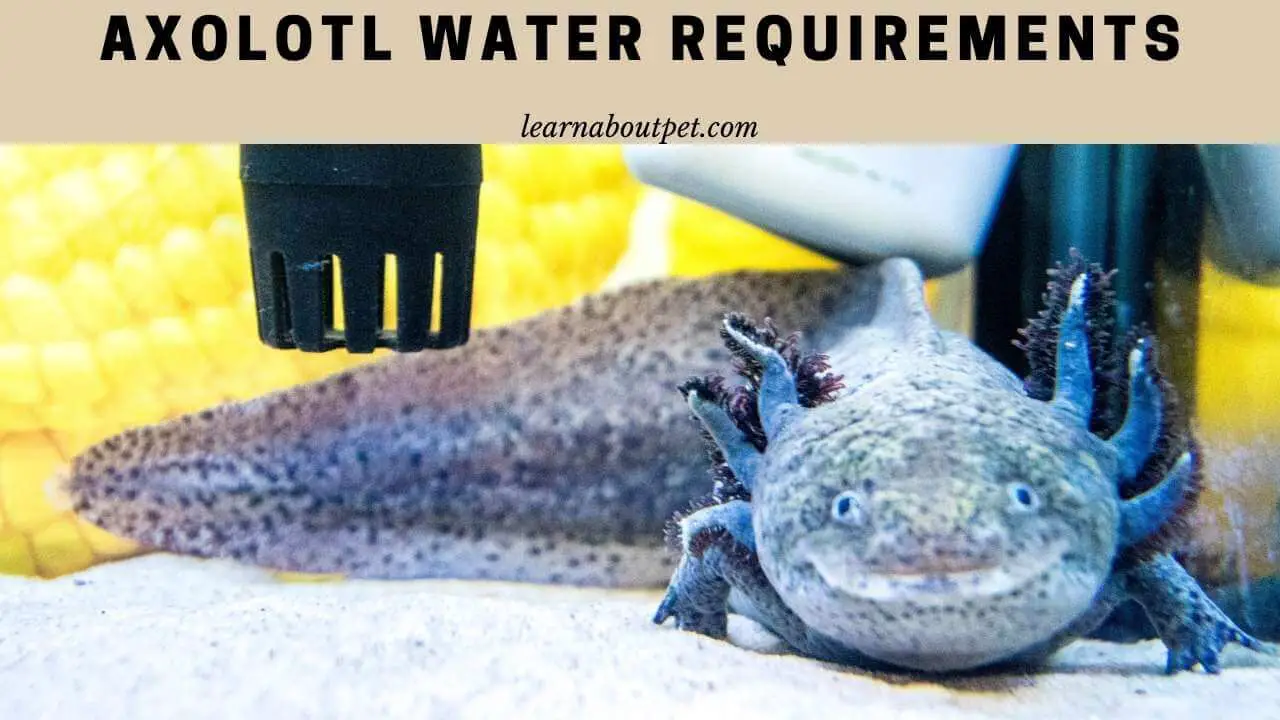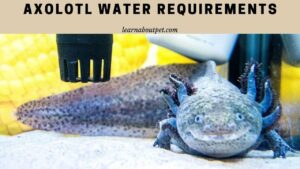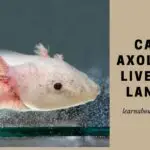Caring for an axolotl is both interesting and challenging because the axolotl is a salamander that is classified as critically endangered, and we need to take care of it until it meets its life expectancy.
Do you know the right Axolotl water requirements? An axolotl in a tank should measure the ideal pH between 7.4 – 7.6 with a cold water temperature of 16-18°C. In addition, axolotl water is classified as slightly hard or brackish water, a water mixture with a concentration of dissolved salts.
Many things need to be considered to maintain axolotl health, such as diet, suitable tanks, and axolotl water requirements. Since there’s a lot to know about water requirements, you’ll need to study this in detail.

What Kind Of Water Do Axolotls Need?
Axolotl needs brackish water or a mixture of freshwater and saltwater. If it’s your first time having aquatic pets, try to learn first about how to process water into brackish water so that the axolotl can be comfortable in your aquarium.
Water is the main thing in axolotl care because axolotl cannot live from tap water because it contains a lot of chlorine. You should use dechlorinated water and a mixture of dissolved salts so that the axolotl can be comfortable in the water with the right pH level.
After having salty water, make sure in your tank to use a filter with a water current that is not too large because the axolotl prefers to live in a place where the water current is calm. If the water current is too heavy, axolotls can stress and harm their health.
When looking for axolotl for sale, make sure you ask the pet store with axolotl water requirements on how to make brackish water and how to change the water every time. This is necessary for the comfort of the axolotl during captivity.
How Much Water Does An Axolotl Need?
Axolotl needs at least 10 gallons of water for a comfortable place to live. The size of the water is reserved for adult axolotls, while young axolotls can be less than that.
The amount you have to pay attention to and the axolotl water parameters such as temperature and pH level. If the axolotl is not at a cool temperature tank, it can suffer heat stroke and stress.
Do not have the tank temperature over 22°C. Make sure you always check the temperature of the tank to avoid drastic temperature changes.
Knowing the temperature in the tank also includes axolotl water requirements because axolotl can’t be at hot temperatures. It can’t even be exposed to direct sunlight. Place the tank in a room that is not exposed to sunlight and only provides UV light to not add heat to the tank.
If you need at least 10 gallons, then you better have a tank size larger than 10 gallons so that the axolotl has a suitable room to swim and play in it. Although alone axolotls also need a large place for them to move.
Do Axolotls Need A Full Tank Of Water?
Although axolotls are bottom dwellers or prefer to be at the bottom of the tank when they are adults, not meeting the tank is also an axolotl water requirements. Axolotl can also jump out of the tank, and that makes you have to anticipate how full of water is needed in the tank.
Give a little difference to the axolotl water in the tank, or give floating plants to become aquarium cover. If you have a 20-gallon tank, you can fill up to 18 liters. If you have a 10-gallon tank, you should fill it up, but provide an aquarium lid to keep the axolotl safe in the tank.
Try not to directly use tap water for axolotl because tap water contains a lot of chlorine and is not good for axolotl health. Use dechlorinated tap water, and you will be safe to put the axolotl into the aquarium.
Axolotls need a lot of water because they produce a lot of waste. If you only have 10-gallon tanks and they need at least the same amount, you will be changing the water very often, which is also not good for the health of the axolotl.
Having a tank that is twice the size of its water requirement will reduce the chances of changing the water more often.
Do Axolotls Need Saltwater?
Axolotls need salt water for several reasons, although they are adapted to being freshwater. When you do an axolotl water change, you can give some salt water mixed with fresh water in their tank.
Do not give table salt because the iodine in the table salt is not good for axolotls. You can give saltwater as in their natural habitat. There are also benefits of saltwater for the axolotl, just as the axolotl does a salt bath.
If given in the right portion, saltwater can treat several conditions in axolotls, such as fungal or infections. You could say saltwater includes axolotl water requirements for several conditions. It is safer if you use salty water for the axolotl aquarium, a mixture of salt and freshwater.
Can I Fill My Axolotl Tank With Tap Water?
You can fill tap water in the axolotl tank if you have used an aquarium water conditioner to remove the chlorine and chloramines. You also need to have a water filter and do water changes if you see the tank is getting dirty.
If the axolotl has started to produce a lot of waste, the axolotl ammonia level will rise. If it is continued, the axolotl will float more often, like wanting to take a breath on the surface water.

You can also check the ammonia level in the tank. Immediately change the water if it is at a certain level so that the axolotl is not exposed to ammonia poisoning. Checking for ammonia and using tap water that has been dechlorinated is included in the axolotl water requirements.
How Often To Change Axolotl Water?
For how often you change the water in the axolotl tank, first see whether you use a water filter or not. If you use a water filter, you can replace 20% of the water once a week. Without a water filter, you can do a 20% water change every other day or everyday seen from the axolotl activity.
Use the axolotl water test kit to see the ammonia level and pH level in the tank if you want to do a weekly water change. Don’t forget to use an axolotl water conditioner for the tap water you use in the tank. Do not directly put tap water into the tank because it is dangerous for axolotls.
After doing a water change, check again using a water test kit to ensure the water condition in the tank is suitable. Changing the water regularly is also axolotl water requirements to always keep the water quality at its best.
Can Axolotl Live In Freshwater?
Axolotls can live in freshwater without any problems. But if you want to equate it with their natural habitat, you can use brackish water to get the same benefits when doing a salt bath.
Axolotl also requires saltwater because water hardness is also included in the axolotl water requirements. Because it requires slightly hard water, it requires a mixture of freshwater and dissolved salts to meet the axolotl’s needs.
Axolotl hard water does not mean including table salt but mineral salts which are more natural and contain no iodine, which can harm the axolotl.
If you are new to axolotl care, ask your pet store which is the best freshwater, saltwater, or brackish water for axolotl life expectancy.
Axolotl Water Parameters Chart
Many things can be used as a reference for axolotl water parameters. Suitable tank, temperature, filter, pH level, and also axolotl water hardness. The table below will make it easier for you to know some of these things.
| Water Parameters | Explanation |
| pH range | Between 7.4 – 7.6 |
| Water quality | Use dechlorinated tap water or bottled water |
| Water temperature | Between 16-18 °C |
| nitrate level | Range of nitrate should be between 20 to 60 ppm |
| Water flow | Need stable water flow |
| Water hardness | Slightly hard from dissolved salts and freshwater |
After knowing some of the parameters, you can understand what you need to pay attention to in axolotl water requirements. Don’t forget to change 20% of the water every once in a while because the axolotl is very quick to contaminate the tank in a matter of days.
Axolotl Not Eating Because Of Water Conditions
Axolotls are animals that will have less appetite if their water contains high levels of ammonia or nitrate. This stresses the axolotl and doesn’t want to eat even if you give it live axolotl food such as worms.
Also, look at the axolotl water temp. If the temperature changes and it rises significantly, chances are your axolotl is overheated and doesn’t want to be given anything from you. They think more about how to get back to the cool temperature.
Suppose the water conditions contain high levels of ammonia, and you force the axolotl to keep eating. In that case, there is a chance that your axolotl will be exposed to ammonia poisoning, and this could be fatal for them.
Although it does not include the axolotl water requirements, this needs to be considered because if your water quality is poor, the axolotl will also not want to be given food by you. If ignored, the axolotl will become thinner and more susceptible to disease.
What Happens If Axolotl Out Of Water?
Axolotls should not be out of the water until they dry out. If they dry out, their slime coat will be shedding and trying to breathe until the air in their lungs runs out. Although axolotls are amphibians, they are unlike other salamanders who can live on land and use their lungs.
You must also require axolotl water depth when you change the water per week. Do not replace more than 20% to anticipate the health of the axolotl that is still in the tank.
Do not let the axolotl jump out of the tank and be out of the water for a long time. This is what you should learn from the axolotl water requirements because too full water will endanger the axolotl from jumping out of the tank.
Too little water in the tank will cause the possibility of poor water replacement due to using too much tap water that still contains a lot of chlorine.
What Can You Put In A Tank With Axolotls?
You can put plants, substrate, rocks, and some decorations that show the natural habitat of the axolotl. Think again if you want to put tank mates in the same tank because axolotls are safer if they live alone in a tank.
Choose a substrate that is safe for your axolotl, so they don’t ingest it. Live plants or fake plants can also be put in the axolotl tank because axolotl appreciates it.
Axolotl as pets does not require much attention if you already know what to prepare for their water requirements. You just have to learn about feeding the axolotl the right way.
Final Verdict On Axolotl Water Requirements
One of the success factors in treating axolotls up to their life expectancy of 10-15 years is to meet each of their water requirements such as temperature in the tank, pH level, nitrate or ammonia level, water current, and water hardness.

Axolotls can be stressed and can lead to disease if the tank has poor water conditions, and they can have less appetite so that the condition of the body worsens.
Using a water filter, checking the tank using a water test kit, and doing a water change once a week are some of the ways to maintain the best water quality for axolotls.

Welcome to Learn About Pet. My name is Rajkumar Ravichandran and I love all pets, travel, and amazing food. I write about my passion and personal experience caring for multiple pets in this blog! ❤️
Post Disclaimer
DISCLAIMER: THIS BLOG OR WEBSITE, "Learn About Pet", DOES NOT PROVIDE YOU WITH MEDICAL ADVICE AND IS NOT A SUBSTITUTE FOR MEDICAL ADVICE. ALWAYS GET IN TOUCH WITH YOUR PERSONAL VETERINARIAN AND USE INFORMATION HERE AS GENERAL ADVICE.
The information, including but not limited to, text, graphics, images and other material contained on this website are for informational purposes only. No material on this site is intended to be a substitute for professional veterinary advice, food recommendation, diagnosis, or treatment. Always seek the advice of your veterinarian or other qualified health care provider with any questions you may have regarding a medical condition or for pet food related questions.







